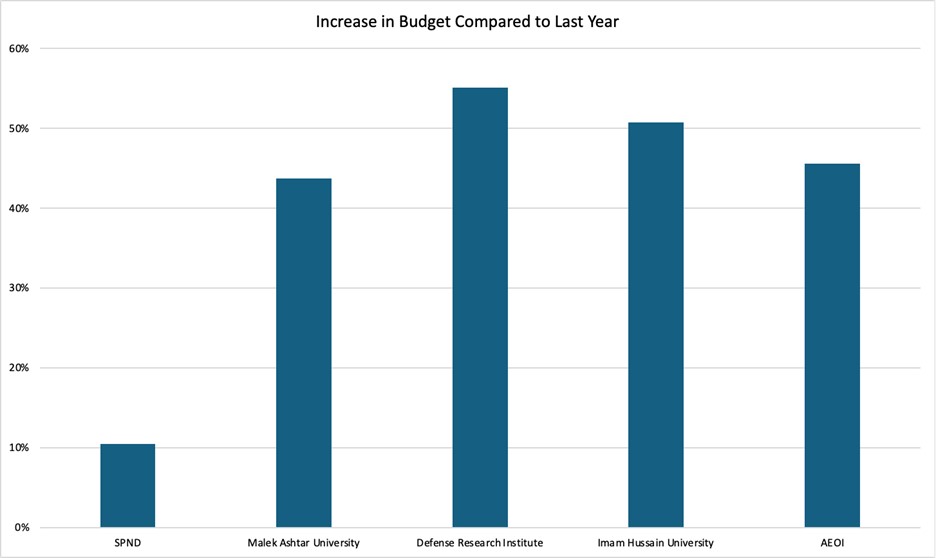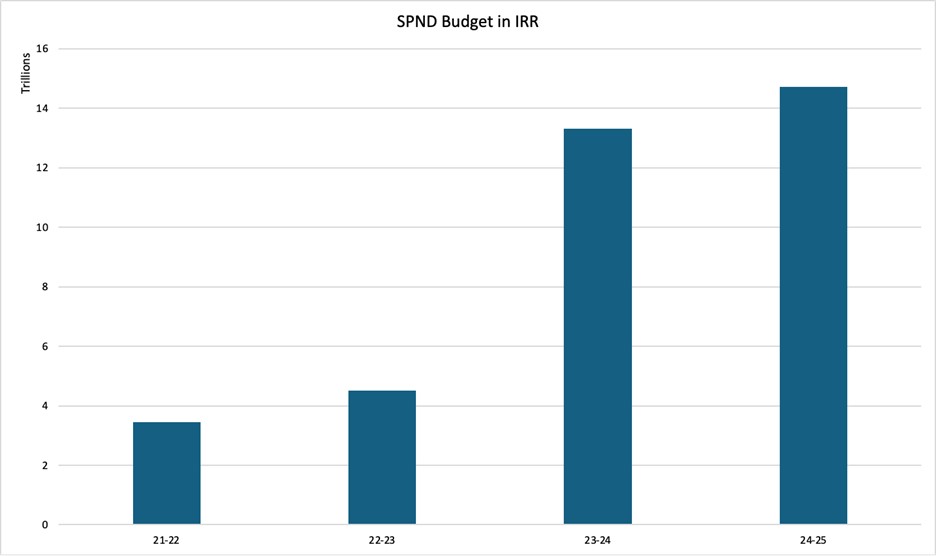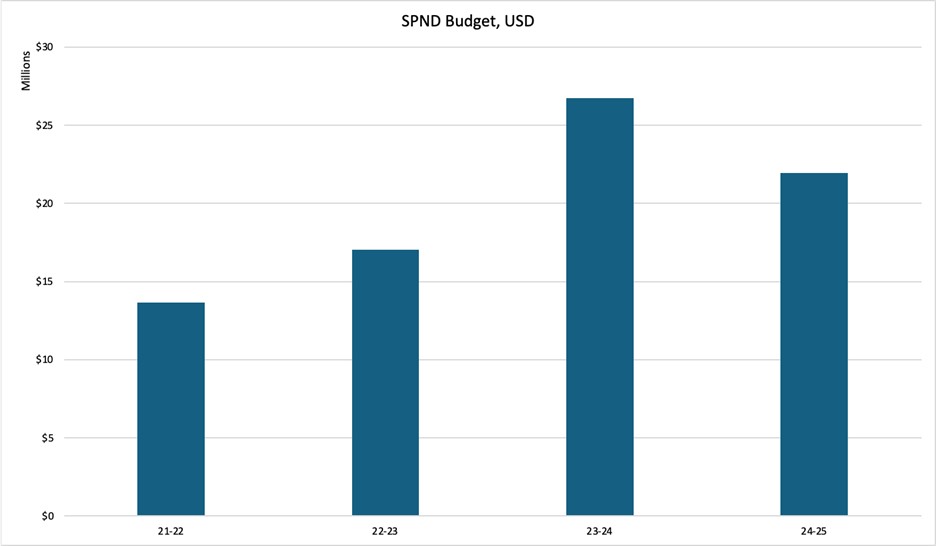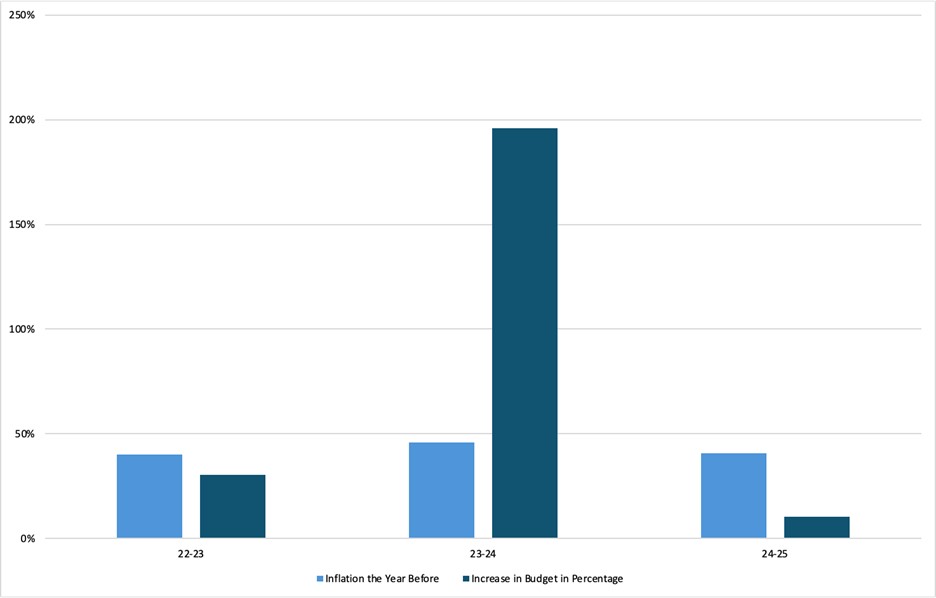Background
SPND is the best-known successor organization of Iran's nuclear weapons program from the early 2000s, which was codenamed the Amad Plan. The organization is known by its Farsi initials SPND or SEPAND, translated into English as "Organization of Defense Innovation and Research." [1] It is believed to be in charge of preserving and advancing the Iranian regime's nuclear weaponization efforts, i.e. the process of making the nuclear weapon itself. Recent developments in its legal structure would enable it to carry out that mission more effectively and secretly.
The SPND commenced operations in 2010 under the Supreme Leader of the Islamic Republic Ali Khamenei's direct mandate as part of the Islamic Republic's Ministry of Defense and Armed Forces Logistics (MODAFL), in response to what was deemed "a strategic and fundamental necessity," [2] circumventing the usual procedures for establishing a government entity in Iran. Mohsen Fakhrizadeh, the head of the Amad Plan, its predecessor the Physics Research Center, and successor organizations to the Amad Plan, remained in charge of SPND until his assassination in late 2020. Befitting a successor organization, SPND had inherited many of the Amad Plan personnel who had been involved in the nuclear program in the early 2000s and had moved to the new organization with Fakhrizadeh. [3] SPND incorporated and expanded the Amad Plan assets in the high explosive and radiation or neutron groups. Following Fakhrizadeh's death, first Mahdi Farahi, and currently Reza Mozaffarinia, both senior Islamic Revolutionary Guard Corps (IRGC) personnel, assumed leadership of the organization. [4]
According to the Islamic Parliament's Speaker of the National Security and Foreign Policy Commission, SPND works on both defensive and offensive technologies such as laser, electromagnetics, acoustics, and most notably nuclear defense. [5] The SPND has a network of subordinate groups and front companies and through those capabilities has been conducting research and procuring capabilities related to nuclear weapons and their delivery systems. [6] This type of networked structure can also incorporate the many former Amad Plan personnel who now work elsewhere at private companies and universities.
New Legal Foundation of SPND
On April 21, 2024, the Islamic Parliament in Iran passed a law, the Law on the Establishment of the Organization for Defense Research and Innovation (SPND), to provide "legal grounds for advancing SPND activities." [7] The recent legislation, crafted by Fakhrizadeh before his death, along with his colleagues and certain members of the current parliament, marked the culmination of 14 years of work to establish this legal basis of SPND. [8] However, that is not the only purpose of the new legislation. A more sinister intent of the new law is to try to hide SPND activities even more from a large part of the regime itself. Article 2 of the law [9] solidifies SPND as an independent government entity with financial, transactional, and administrative independence with an exemption from the National Audit Office and likely even the Parliament's oversight. Although the law maintains SPND's association with the MODAFL, a member of the Islamic Parliament pointed out that it is unclear whether or not SPND remains a subsidiary of the ministry, an ambiguity that could directly undermine oversight of its activities by the Parliament. Additionally, Article 5 grants SPND "all the advantages, preferences, and exemptions" of military-related entities.
In bypassing the MODAFL, the new legislation puts SPND immediately under the authority of the General Staff of the Armed Forces which is the highest-ranking military entity, and is appointed by the Supreme Leader. According to Article 3, the technologies that SPND is supposed to cover in its research "are set by the General Staff and informed to SPND through MODAFL."
Working with Universities
Article 4 of the legislation allows SPND to establish subsidiary research institutions and companies to advance its projects. However, this is merely a modest legal recognition of a long-used strategy by SPND and its predecessors in charge of the regime's nuclear weapons program, in order to evade detection. [10]
Traditionally, people involved with the nuclear program have held positions at the Islamic Revolutionary Guard Corps (IRGC) and MODAFL-affiliated universities, and they have cooperated with major Iranian universities to provide civilian cover for their activities and to train and recruit talent for the program. According to Reza Talaei-Nik, the Defense Ministry's spokesman, "MODAFL [which SPND has been part of] has contractual cooperation with 100 universities and 1,200 knowledge enterprises but there needs to be an organization in charge of this task [of coordinating these contracts]." [11]
Budget
Article 6 of the SPND legislation bill vaguely mentions that SPND is established using the "human resources and capabilities" of the MODAFL and "extra financial resources are dependent on provisions in the annual budget." This ambiguous statement comes after years during which SPND (an unlegislated entity at the time) has been provided a dedicated budget line in Iran's annual budget, albeit one that does not include all its annual expenditures. These budget numbers cannot explain SPND's facilities and activities that are publicly known. This public budget may not, for example, include external monies supplied for national projects. Nonetheless, these public budgets indicate SPND's central importance and staying power.
Iran's budget table divides each entity's credits from the public budget into three categories: "expenditure" for administrative expenses, "acquisition of capital assets" for building infrastructure, and "exclusive" for special uses (see Figure 1). [12] The exclusive budget credit is an exemption that gets around the regular parliament allocation of government entities. The exclusive credit is granted as an exemption and is the organization's revenue that, instead of going to the public budget and being allocated annually by the parliament, returns to the organizations for special uses. [13] The entities that are granted the exclusive credit are normally entities that either collect state revenues or offer services on top of their state-mandated tasks, such as higher education institutions and hospitals. [14] SPND has the largest exclusive budget credit in all of the regime's armed forces, by a very significant margin. SPND's exclusive budget makes up more than 50 percent of the exclusive budget for all military organizations in the regime (followed by the MODAFL's dedicated budget line and Malek Ashtar University), whereas its total budget is less than one percent of the overall defense budget. This unique distribution of SPND's budget has a clear indication: the leadership of the regime wants to keep SPND's operation financially independent, autonomous, and confidential, even from the other parts of the government.
What ensures the autonomy of SPND and similar organizations is the armed forces' oil revenue on top of the regular budget and their authority to export it. In the recent budget, the armed forces of the regime are allotted more than 21 percent of the annual oil revenue valued at around 4.5 billion euros for "strengthening the defense capabilities of military institutions." According to Article B of Annex 4 of this new budget bill, if the executive branch fails to deliver the determined budget, "the Ministry of Petroleum is obligated to compensate for the shortfall by delivering crude oil or gas condensates to legal entities designated by the General Staff of the Armed Forces." [15] This phenomenon of the armed forces', and specifically the IRGC's, involvement in exporting oil and gas has been occurring implicitly dating back to Mahmoud Ahmadinejad's presidency (2005-2013), but it first showed up in the initial budget of President Ebrahim Raise's (2021-2024). This credit has tripled in size since last year.

Figure 1. SPND's budget line in the 24-25 annual budget.
Even though the publicly available numbers in the budget do not represent SPND's full budget or financial resources, they provide valuable insights. Since its establishment, SPND's budget has been generally on the rise, with a significant jump in the 2023/2024 budget (see Figure 3). However, unlike with every other defense-related research organization (see Figure 2), the increase in SPND's budget has been marginal in the recent bill, decreasing in the USD-adjusted number and not keeping up with inflation as shown in Figures 4 and 5. In practical terms, this means shrinking SPND's resources which, given the new legislation, seems incongruous. A more realistic explanation is that the SPND's resources are disappearing from the public budget, shielding the organization from any form of oversight.
Conclusion
With the new law, the Islamic Republic is solidifying ways to further isolate SPND from other parts of the government and armed forces through exemptions from oversight, independent and untransparent financial resources, and the establishment of front companies. This uniquely positions SPND at the highest level of confidentiality, making it accessible only to a few of the highest-ranking regime officials. This is likely to give the organization greater versatility and access to resources, allowing greater freedom to act upon the regime's leadership orders with a minimized risk of detection. If the Iranian regime decides to build nuclear weapons, SPND is better situated to carry out that order effectively and secretly.

Figure 2. SPND and other defense-related research organizations' increase in budget in percentage compared to last year.

Figure 3. SPND's annual budget in Iranian Rial for the last four years.

Figure 4. SPND's annual budget in the last five years adjusted based on the USD exchange rate in the open market roughly at the time of the passing of the budget.

Figure 5. The increase in SPND's budget compared to the inflation during the year before, based on the Statistical Center of Iran annual reports.
1. David Albright with Sarah Burkhard and the Good ISIS Team, Iran's Perilous Pursuit of Nuclear Weapons (Washington, D.C.: Institute for Science and International Security Press, 2021). [↩]
2. "Parliament's gift to the Ministry of Defense: How does the SPND organization help the armed forces?" KhabarOnline, April 21, 2024, khabaronline.ir/xm8sQ. [↩]
3. David Albright with Sarah Burkhard and the Good ISIS Team, Iran's Perilous Pursuit of Nuclear Weapons (Washington, D.C.: Institute for Science and International Security Press, 2021). [↩]
4. "Deputy Minister of Defense: The Islamic Republic of Iran is among the innovative defense powers," [Translated from Farsi], Malek Ashtar University of Technology, August 19, 2023, https://mut.ac.ir/site/blog/3362/%D8%AC%D8%B2%D9%88-%D9%82%D8%AF%D8%B1%D8%AA%E2%80%8C%D9%87%D8%A7%DB%8C-%D9%86%D9%88%D8%A2%D9%88%D8%B1-%D8%AF%D9%81%D8%A7%D8%B9%DB%8C-%D8%B4%D8%AF%D9%87%E2%80%8C%D8%A7%DB%8C%D9%85. [↩]
5. "The general plan for the formation of the 'SPND' organization of the Ministry of Defense was approved," [Translated from Farsi], Mehrnews, April 20, 2024, https://www.mehrnews.com/news/6084178/%DA%A9%D9%84%DB%8C%D8%A7%D8%AA-%D8%B7%D8%B1%D8%AD-%D8%AA%D8%B4%DA%A9%DB%8C%D9%84-%D8%B3%D8%A7%D8%B2%D9%85%D8%A7%D9%86-%D8%B3%D9%BE%D9%86%D8%AF-%D9%88%D8%B2%D8%A7%D8%B1%D8%AA-%D8%AF%D9%81%D8%A7%D8%B9-%D8%AA%D8%B5%D9%88%DB%8C%D8%A8-%D8%B4%D8%AF. [↩]
6. "U.S. Government Sanctions Organizations and Individuals in Connection with an Iranian Defense Entity Linked to Iran's Previous Nuclear Weapons Effort," U.S. Department of Treasury, March 22, 2019, https://home.treasury.gov/news/press-releases/sm634. [↩]
7. "The law on the establishment of the Defense Research and Innovation Organization (SPND)," Islamic Parliament Research Center, May 15, 2024, https://rc.majlis.ir/fa/law/show/1804601. [↩]
8. "Parliament's gift to the Ministry of Defense: How does the SPND organization help the armed forces?" [↩]
9. "The law on the establishment of the Defense Research and Innovation Organization (SPND)". [↩]
10. [1] In 2009, for example, the Times of London revealed a document titled "Outlook for special neutron-related activities over the next four years" describing Iran's plan to build a neutron generator and the government's use of academic covers to assist that effort which was key to furthering the nuclear weapons program. See, Mark Gorwitz, Mohammadreza Giveh, and David Albright, "Iran's Likely Violations of Section T: Computer Modeling Relevant to Nuclear Weapons Development," Institute for Science and International Security, September 10, 2024, https://isis-online.org/isis-reports/detail/irans-likely-violations-of-section-t-computer-modeling-relevant-to-nuclear#:~:text=Despite%20the%20prohibition%2C%20a%20large,decentralized%20manner%20with%20academic%20covers, and "Farsi and English Versions of Document on Neutron Initiator," Institute for Science and International Security, December 14, 2009, https://isis-online.org/isis-reports/detail/farsi-and-english-versions-of-document-on-neutron-initiator/. [↩]
11. "Parliament's Gift to the Ministry of Defense: How Does the SPND Organization Help the Armed Forces?" [↩]
12. "Acquisition of capital assets (development costs)," [Translated from Farsi], Iran Budget website glossary, https://iranbudget.org/glossary#:~:text=%D8%A7%D8%B9%D8%AA%D8%A8%D8%A7%D8%B1%D8%A7%D8%AA%20%D9%87%D8%B2%DB%8C%D9%86%D9%87%E2%80%8C%D8%A7%DB%8C%20(%D9%87%D8%B2%DB%8C%D9%86%D9%87%E2%80%8C%D9%87%D8%A7%DB%8C%20%D8%AC%D8%A7%D8%B1%DB%8C)%D8%A7%DB%8C%D9%86,%D9%87%D8%B2%DB%8C%D9%86%D9%87%20%D8%A7%D8%B1%D8%A7%D8%A6%D9%87%20%D8%AE%D8%AF%D9%85%D8%A7%D8%AA%20%D8%B9%D9%85%D9%88%D9%85%DB%8C%20%D8%A7%D8%B3%D8%AA. [↩]
13. "Exclusive Credits in the Annual Budget - Iran Market Report," [Translated from Farsi], Soobazar, December 2019, https://soobazar.com/reports/%D8%A8%D9%88%D8%AF%D8%AC%D9%87/%D8%A7%D8%B9%D8%AA%D8%A8%D8%A7%D8%B1%D8%A7%D8%AA-%D8%A7%D8%AE%D8%AA%D8%B5%D8%A7%D8%B5%DB%8C-%D8%AF%D8%B1-%D8%A8%D9%88%D8%AF%D8%AC%D9%87-%D8%B3%D8%A7%D9%84%D8%A7%D9%86%D9%87-%DA%AF%D8%B2%D8%A7%D8%B1%D8%B4-%D8%A8%D8%A7%D8%B2%D8%A7%D8%B1-%D8%A7%DB%8C%D8%B1%D8%A7%D9%86, Quoting from Development Research Center of the Planning and Budget Organization's report. [↩]
14. M. Hosseini, M. Fatehizadeh, "Nature of exclusive revenue and its status in budget," Parliament and Strategy, vol. 20, no. 84, pp. 303-336, 2015. [↩]
15. "21 percent of oil sales allocated to the armed forces/104 million barrels of Iranian oil under military control," [Translated from Farsi], Tejarat News, November 22, 2023, https://tejaratnews.com/n/4Wpb. [↩]






